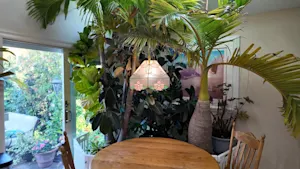More Stories
Meteorological winter starts on Dec. 1, that’s the beginning of the coldest part of the year in our part of the world. It’s not exactly ideal gardening weather, but there are a few plants that can handle cold and bring some very impressive color.
Pansies

During mild years, Pansies bloom longer than any annual I plant for the summertime. Last year the pansies I planted in October bloomed until June. That’s nearly 10 months of nonstop blooms!
Pansies come in an impressive variety of flower sizes and colors. Some are very fragrant too! They require full sunshine to bloom and prefer temperatures between 30F and 80F for their best performance. The flowers can survive brief drops down to 20F and the leaves will survive temperatures down to 15F.
Snow can crush these plants, but they will bounce back in late winter after the snow melts. For better blooming, I bring my pansies into the garage when heavy snow is in the forecast or if nighttime temperatures are regularly dropping near or below 20F.
Did you know pansy flowers can also brighten up your winter cooking? The flowers are edible and have a minty taste (great for desserts). Most of the pansies sold at nurseries are treated with pesticides, so if growing pansies for food, it’s best to start from seed. Seeds sprout very easily, but seedlings are not cold tolerant so they’ll need to be started in late summer or early spring for the best crop of blooms!
Cyclamen

This is a great option to bring color to a shade garden. Hardy Cyclamen will survive our winters and live for many years. These bloom in either spring or Autumn in our climate and have similar growing requirements to Hosta. Unfortunately, Hardy Cyclamen are not the type that are available at local stores.
The most commonly sold species is the Floral Cyclamen (Cyclamen persicum). It’s not cold-tolerant enough to survive our winters and is usually sold as a houseplant, however, it can survive some cold! The blooms can handle temperatures below 30F and the leaves down to 25F as long as it’s in a large enough pot to keep the soil from freezing. They are one of the few flowering plants that work well in shade in late Autumn and early winter.
Cyclamen can be brought inside over the winter. They will lose all their leaves in the summer when the days are longer, but keep taking care of them because they’ll return next year!
Broadleaf evergreens

Some shrubs and trees keep their large, glossy leaves all year long. They don’t have impressive flowers, but they do bring beautiful texture and height to your planters.
Fatsia Japoncia and Cast Iron Plants are often sold as cheap houseplants, but can survive temperatures down to 10 degrees! Their large, glossy leaves make great winter planters and can be brought inside during the worst of winter.
Aucuba is a more cold-tolerant option! They come in a variety of foliage colors and patterns like “Gold Dust” which has specks of yellow and white or “Ooba Nakafu” which has incredible yellow coloration on the center of each leaf.
Conifers

There are so many incredible trees and shrubs that make a big impact as tiny plants in containers, just like they do all year long in the landscape! The tall and skinny growth habit of arborvitaes makes them perfect as the centerpiece in a winter container. Decorate them with lights for an even more festive look.
There’s no need for lights to make “Yellow Globe” arborvitae shine. The foliage is bright yellow all year long. These have a mounting growth habit that keeps them small and tidy.
If you have large branches handy, put them to use and stick them in the soil. They’ll add impressive height to containers and make them look more interesting. Pines and other conifer cuttings will keep their green all winter if they are cut during cooler weather and kept in shade. Unfortunately, they will not sprout into new plants though.
Ornamental Kale and Cabbage

These fun leafy greens come in awesome colors like purple, and even pure white. The leaves hold up to light snow and temperatures below 15 degrees. They are edible too - it’s just kale and cabbage after all! Ornamental kale and cabbage, like pansies, are often treated with pesticides that do not make them suitable for eating, but they are still beautiful to look at.
To summarize
These are just a few ideas to dress up those bare garden containers during the winter. It’s beneficial to use containers this time because it gives you more control over how they look and how to care for them. With winter containers, you have the option to bring tender plants inside during the coldest weeks of the year and place them into more shade when longer days and warmer weather return. Container plants are also less tempting for critters who love eating fresh greens.
Got some pesky garden problems that you just can't solve? Ask Alex here!
More from News 12
1:48

Autumn gardening: When to prune, what to plant & why to leave the leaves
1:47

Garden Guide: How to bring your tropical outdoor plants inside for winter
1:39

Garden Guide: Fall in love with chrysanthemums
1:35

Spend a few minutes now to get FREE flowers next summer!
2:35

More than just pumpkins: Plants to add color, charm this Halloween season
1:44
